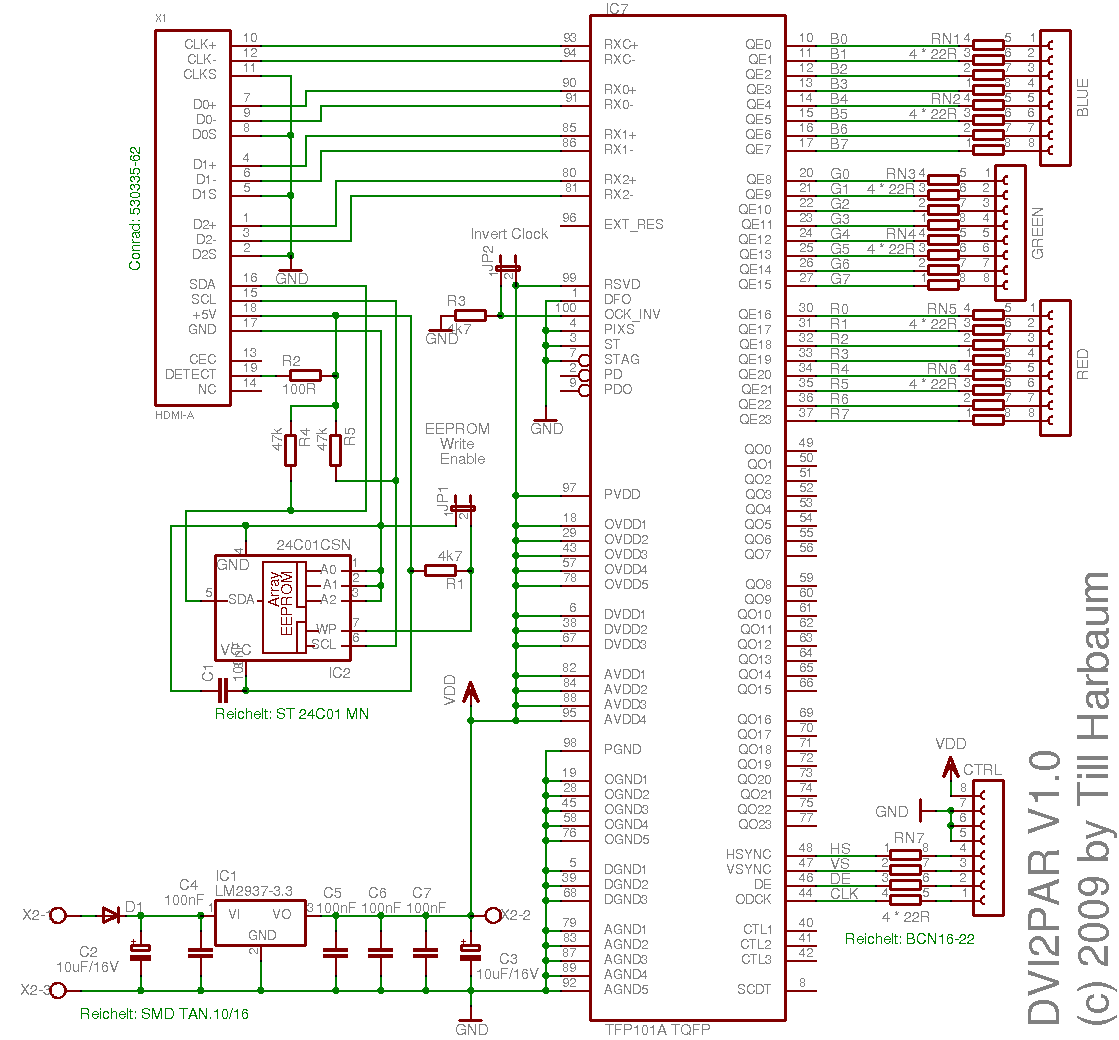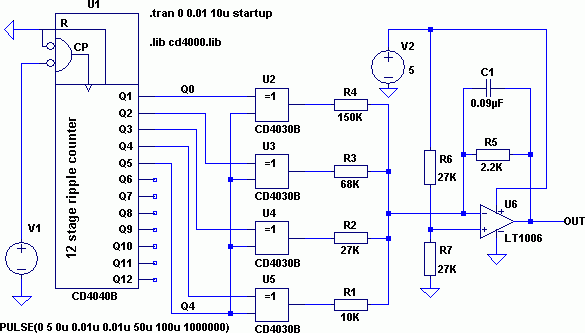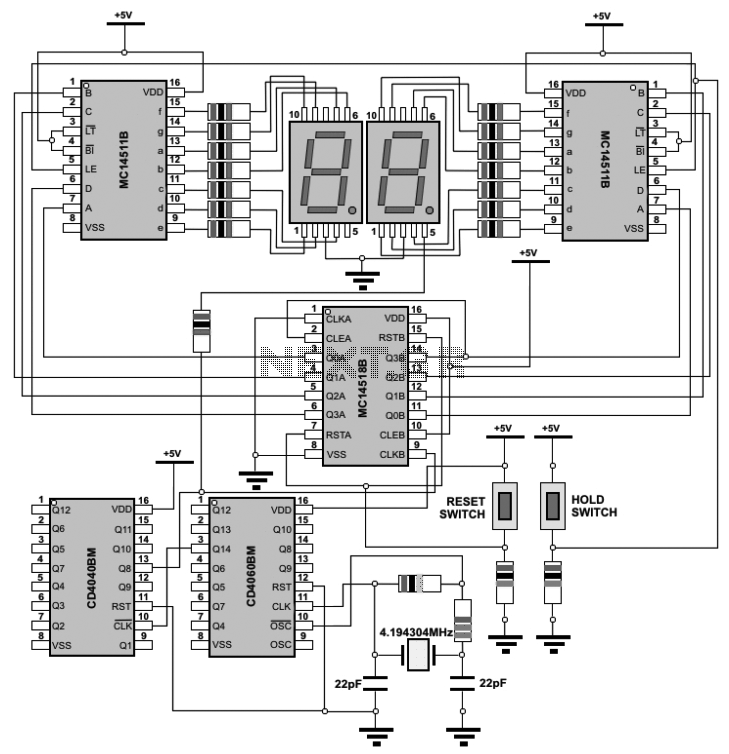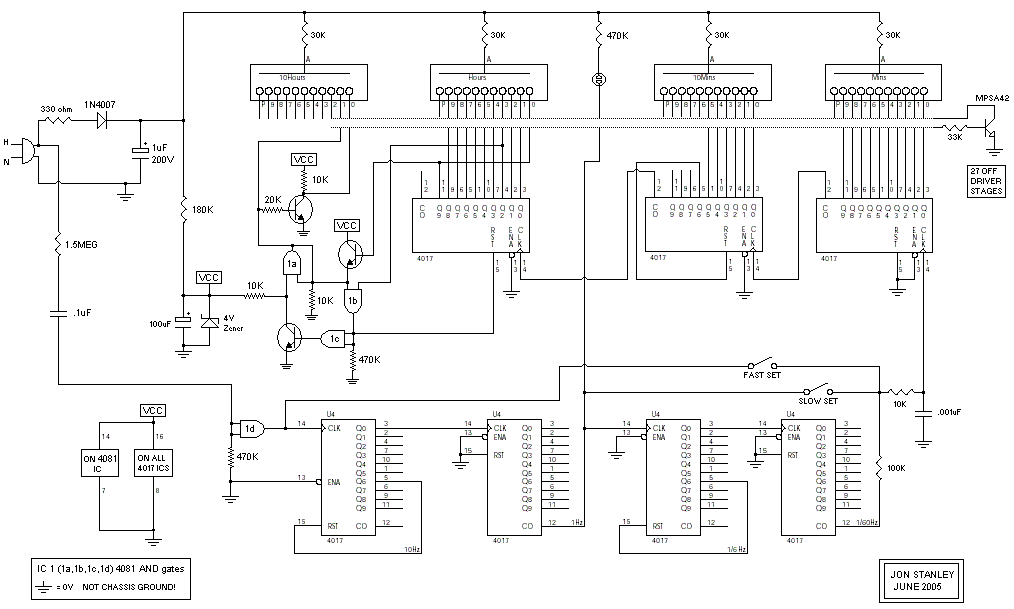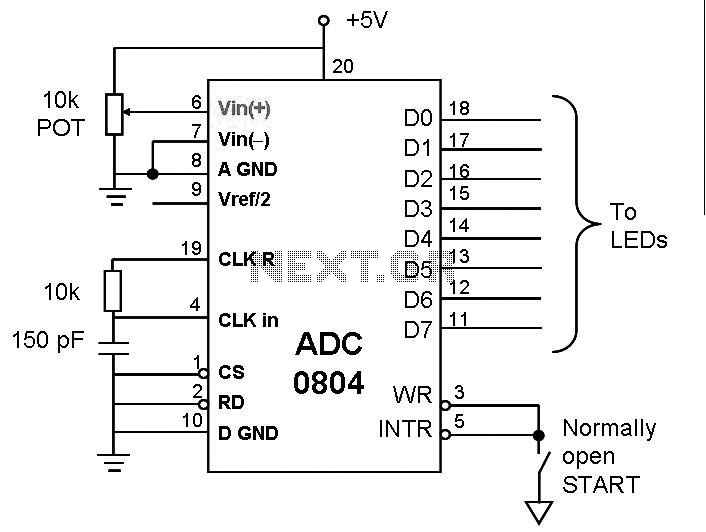
Digital Clock
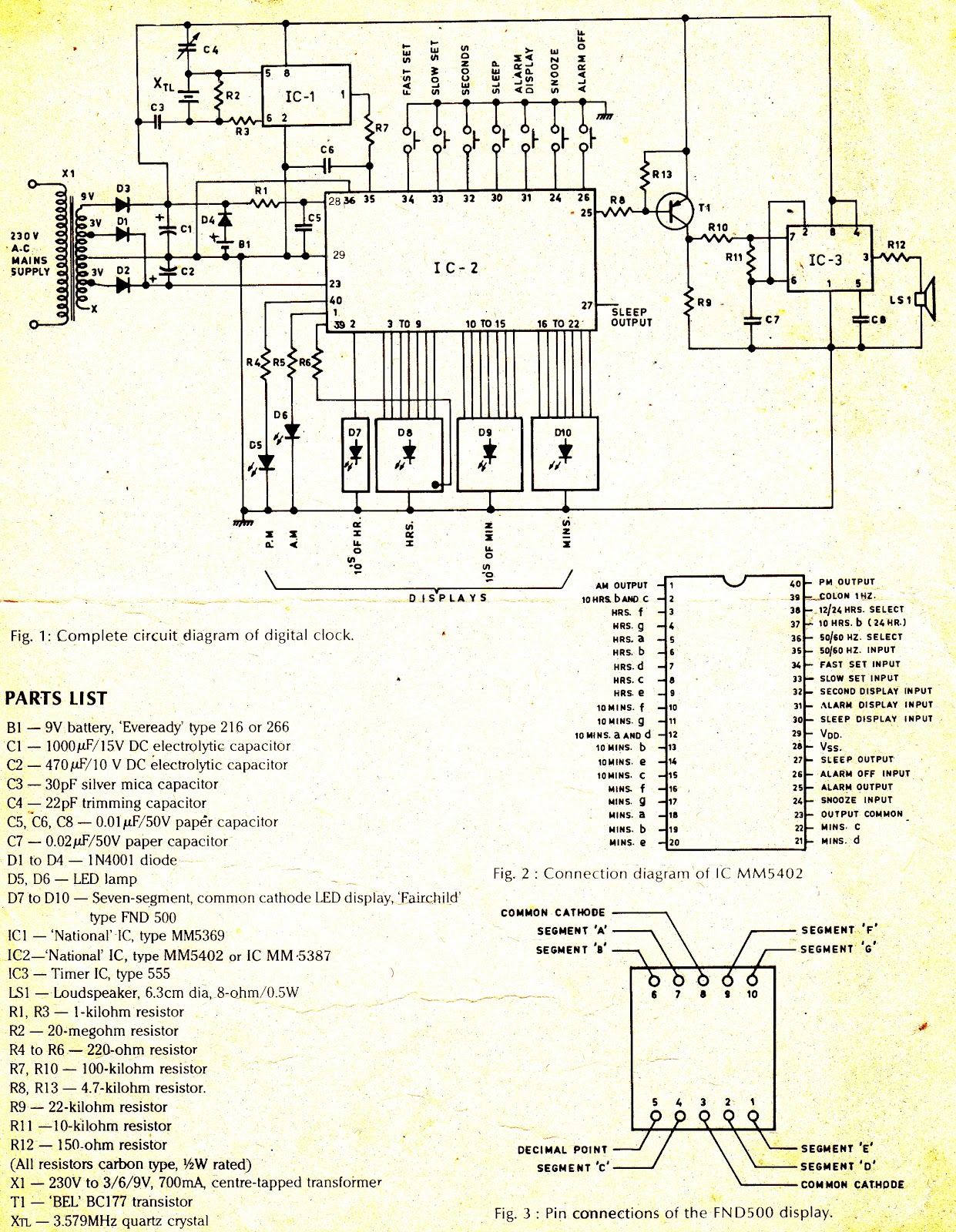
The complete circuit diagram is shown in Figure 1. The heart of the system is IC2, National's MM5402 clock chip, which is a MOS monolithic large-scale integrated circuit. Its pin configuration is illustrated in Figure 2. The supply is derived from the mains through a low-voltage step-down transformer (X1). As depicted in the diagram, a 9-volt DC supply, obtained through diode D3 and capacitor C1, is fed to the counting circuit of the clock chip at pin 29 via a 1kΩ resistor. A bypass capacitor C5 is utilized at the input of the clock chip to protect against high-frequency transients. The current requirement for the entire clock chip is approximately 4.5 mA. The clock input at pin 35 receives 60Hz clocked pulses, which are generated by a 3.579 MHz quartz crystal oscillator formed with IC1, National's MM5369 chip, which also functions as a frequency divider. Its output at pin 1 is a 60Hz square wave. A trimmer capacitor (C4) is included for trimming the crystal frequency to enhance time accuracy. For display purposes, Fairchild's FND500 seven-segment light-emitting diodes (LEDs), D7 to D10, are utilized. These are common-cathode LEDs, and since the clock chip's segment output is around 10 mA, no additional interfacing is necessary. The various LED segments can be directly connected to the respective clock outputs. In total, four LED displays are required, which can be easily soldered onto a separate PCB or breadboard. The power supply for the display LEDs is sourced from the 3V tap of transformer X1. The pin configuration of FND500 is shown in Figure 3. The blinking colon feature is also available in the FND500 display, connected at pin 5 of the display through a 220-ohm current-limiting resistor to pin 39 of the clock chip. The AM and PM indicators are represented by two LED lamps, D5 and D6, connected to pins 1 and 40 of the clock chip through 220-ohm current-limiting resistors. All display functions are achieved by connecting push-button switches to various control inputs and grounding the respective inputs. In the prototype, a self-assembled seven-reed assembly of switches was utilized; however, miniature calculator keyboard switches made by O/E/N India Ltd are recommended for better performance. An alarm output is available at pin 25 of the clock chip. Since this output is relatively low, a current driver is employed, consisting of transistor T1 and a few supporting components as shown. For a gentle alarm sound, a tone is generated by IC3, which is an Indian timer IC 555. The tone can be adjusted by changing the value of capacitor C7. An 8-ohm, 0.5-watt speaker with a diameter of 6.3 cm should produce sufficient sound to be heard across the room. The sleep output at pin 27 of the clock chip is similarly amplified and used to drive a relay that can control any audio or electrical equipment. The sleep timer function is designed to turn off devices such as a radio, tape recorder, or TV after a preset duration, with a maximum of 59 minutes. As both the clock chip and the crystal oscillator-divider IC operate on a 9V supply (with an actual operating range of 7 to 11 volts), a battery backup system can be implemented to maintain clock operation during mains failure. While the clock is powered by this backup system, the time display will not be visible, but upon resumption of AC mains power, the clock will automatically display the correct time. If the supply to the clock chip is interrupted for any reason, all digits will flash at 1Hz to indicate that the displayed time is incorrect.
The circuit operates on a well-defined architecture, leveraging the capabilities of the MM5402 clock chip and the MM5369 frequency divider to maintain accurate timekeeping. The design incorporates essential components such as the step-down transformer, diodes, capacitors, and LEDs, which work together to create a functional timekeeping system. The choice of components ensures reliability and ease of assembly, making it suitable for both amateur and professional applications. The inclusion of a battery backup system enhances the robustness of the circuit, ensuring continued operation during power outages, which is critical for time-sensitive applications. Additionally, the use of a relay for sleep timer functionality allows for versatile control over connected devices, enhancing the overall utility of the clock system. The design emphasizes simplicity in user interaction through push-button controls, providing a user-friendly experience while maintaining technical integrity.The complete circuit diagram is shown in Fig. 1. Heart of the system is lC2, National`s MM5402 clock chip. It is an MOS monolithic large scale integrated circuit. It`s pin configuration is shown in Fig. 2. The supply is derived from the mains through a low-voltage stepdown transformerXl. As shown in the diagram, 9-volt DC supply derived by diode D3 and capacitor Cl is fed to the counting circuit of the clock chip at pin 29 through a lk resistor. A bypass capacitor C5 is used at r input of clock chip for protection from high-frequency transients.
The current requirement for the entire clock chip is around 4. 5 mA. . The clock input pin 35 is fed by 60Hz clocked pulses. These are derived by 3. 579 MHz quartz crystal oscillator formed with ICI, Nationals MM5369 chip, which is also ia frequency divider. Its output at pin I is 60Hz square wave For trimming the crystal frequency, a trimmer (C4) is also provided which could be used for improving the accuracy of time.
For display, Fairchild`s FNDSOO seven-segment light emitting diodes (LEDs), D7 to D10, are used. These are common-cathode LEDs. Since the clock chip`s segment output is of the order of lO mA, no interfacing is required. The various LED segments are only to be connected to the respective clock outputs. In all, four LED displays are required, and these can be straightaway soldered on to a separate PCB or breadboard. Supply to the display LED is obtained from the 3V tap of transformer Xl. The pin configuration of FND500 is shown in Fig. 3. The blinking colon is also available in the FND500 display. It is provided at pin 5 of the display, and may be connected through a 220-ohm current limiting resistor to pin 39 of the clock chip.
The a. m. and pm. displays are obtained by using two LED lamps, D5 and D6, and connected to pins I and 40 of clock chip through 220-ohm current limiting resistances. All the U`Eplay functions are obtained by simply connecting push-button switches at various control inputs, and grounding the respective input.
In the prototype a self- assembled seven-reed assembly of switches was used. However, though costlier, the miniature calculator keyboard switches made by O/E/N India Ltd are the best for this purpose. Alarm output is available at pin 25 of the clock chip. Since this output is quite low, a current driver is used. This driver is formed by the transistor Tl and a few supporting components, as shown. Fora gentle alarm sound, tone is generated by lC3, which is an Indian timer IC 555. The tone can be varied by changing the value of capacitor C7. An 8 ”ohm, 0. 5- watt speaker of 6. 3 cm dia should produce sufficient sound to be heard across the room. _ The sleep output at pin 27 of the clock chip is similarly amplified and used to drive a relay which can control any audio or electrical equipment.
The function of sleep timer is to switch off a radio set, tape recorder, TV etc after a preset time, within the maximum duration of 59 minutes. Since the clock chip as well as the crystal oscillator-cum- divider IC operate on 9V supply (actual operating range : 7 to ll volt), a battery back ”up system can be used to keep the clock running during mains failure.
There will be no display of time while the clock is running on this back-up system, but on the resumption of power through AC mains the clock will automatically display the correct time. lf due to any reason supply to the clock chip is cut off, all the digits will flash at lHz to indicate that time displayed is incorrect.
🔗 External reference
The circuit operates on a well-defined architecture, leveraging the capabilities of the MM5402 clock chip and the MM5369 frequency divider to maintain accurate timekeeping. The design incorporates essential components such as the step-down transformer, diodes, capacitors, and LEDs, which work together to create a functional timekeeping system. The choice of components ensures reliability and ease of assembly, making it suitable for both amateur and professional applications. The inclusion of a battery backup system enhances the robustness of the circuit, ensuring continued operation during power outages, which is critical for time-sensitive applications. Additionally, the use of a relay for sleep timer functionality allows for versatile control over connected devices, enhancing the overall utility of the clock system. The design emphasizes simplicity in user interaction through push-button controls, providing a user-friendly experience while maintaining technical integrity.The complete circuit diagram is shown in Fig. 1. Heart of the system is lC2, National`s MM5402 clock chip. It is an MOS monolithic large scale integrated circuit. It`s pin configuration is shown in Fig. 2. The supply is derived from the mains through a low-voltage stepdown transformerXl. As shown in the diagram, 9-volt DC supply derived by diode D3 and capacitor Cl is fed to the counting circuit of the clock chip at pin 29 through a lk resistor. A bypass capacitor C5 is used at r input of clock chip for protection from high-frequency transients.
The current requirement for the entire clock chip is around 4. 5 mA. . The clock input pin 35 is fed by 60Hz clocked pulses. These are derived by 3. 579 MHz quartz crystal oscillator formed with ICI, Nationals MM5369 chip, which is also ia frequency divider. Its output at pin I is 60Hz square wave For trimming the crystal frequency, a trimmer (C4) is also provided which could be used for improving the accuracy of time.
For display, Fairchild`s FNDSOO seven-segment light emitting diodes (LEDs), D7 to D10, are used. These are common-cathode LEDs. Since the clock chip`s segment output is of the order of lO mA, no interfacing is required. The various LED segments are only to be connected to the respective clock outputs. In all, four LED displays are required, and these can be straightaway soldered on to a separate PCB or breadboard. Supply to the display LED is obtained from the 3V tap of transformer Xl. The pin configuration of FND500 is shown in Fig. 3. The blinking colon is also available in the FND500 display. It is provided at pin 5 of the display, and may be connected through a 220-ohm current limiting resistor to pin 39 of the clock chip.
The a. m. and pm. displays are obtained by using two LED lamps, D5 and D6, and connected to pins I and 40 of clock chip through 220-ohm current limiting resistances. All the U`Eplay functions are obtained by simply connecting push-button switches at various control inputs, and grounding the respective input.
In the prototype a self- assembled seven-reed assembly of switches was used. However, though costlier, the miniature calculator keyboard switches made by O/E/N India Ltd are the best for this purpose. Alarm output is available at pin 25 of the clock chip. Since this output is quite low, a current driver is used. This driver is formed by the transistor Tl and a few supporting components, as shown. Fora gentle alarm sound, tone is generated by lC3, which is an Indian timer IC 555. The tone can be varied by changing the value of capacitor C7. An 8 ”ohm, 0. 5- watt speaker of 6. 3 cm dia should produce sufficient sound to be heard across the room. _ The sleep output at pin 27 of the clock chip is similarly amplified and used to drive a relay which can control any audio or electrical equipment.
The function of sleep timer is to switch off a radio set, tape recorder, TV etc after a preset time, within the maximum duration of 59 minutes. Since the clock chip as well as the crystal oscillator-cum- divider IC operate on 9V supply (actual operating range : 7 to ll volt), a battery back ”up system can be used to keep the clock running during mains failure.
There will be no display of time while the clock is running on this back-up system, but on the resumption of power through AC mains the clock will automatically display the correct time. lf due to any reason supply to the clock chip is cut off, all the digits will flash at lHz to indicate that time displayed is incorrect.
🔗 External reference
